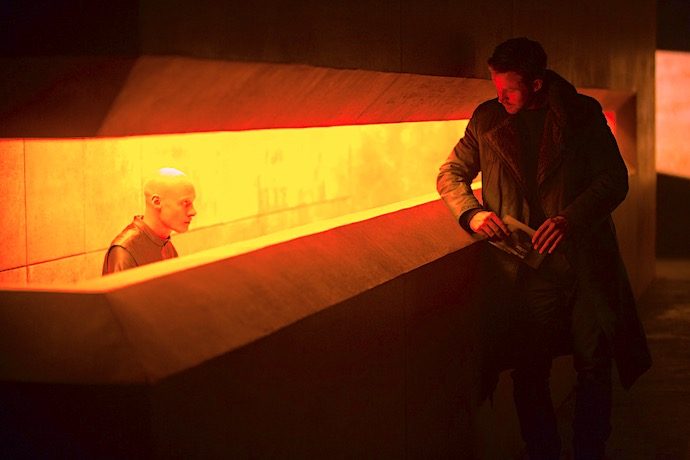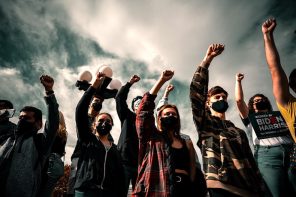Cinema and religion are never far apart—both bring light to darkened places. Sometimes the illumination comes from bright souls gathered together to confront dark forces. Sometimes it’s the light of bonfires lit to root out (perceived) monsters. Sometimes the light beckons to us from outside the window, or at the end of a tunnel, showing us another world beyond, full of possibilities. The lights are at times alluring, and other times frightening, and usually a bit of both.
It may sound strange to say, but in an era of fake news and truthiness, we might need the lights of fiction now more than ever. Yes, for a kind of escape (though the belief in cinema simply as escapism is a dangerous tale), but also for testing, trying, experimenting, becoming other. In the cinema we are given the point of view of someone else, made to feel what someone else does, prompted to become part of the stories playing out on screen.
For the white, middle-class, heterosexual male, a vast majority of big-budget films are designed to reaffirm that status. But a solid, and important, number of films slip out of those confines and light up by looking over the shoulder of a mute woman from the 1950s, of cloistered women from the 1960s, of Mexican boys in the technicolor land of the dead, and beasts at the edge of the human. We step out of the darkness and enter their worlds, becoming changed, perhaps a little enlightened, by the process.
Like most years, this year’s range of fiction films showed the ways cinema and religion can brighten each other’s paths, in a variety of ways that I’ll briefly note below. Meanwhile, the fiction of ranking films should be apparent: there is no singular truth in this process, and I would not expect a single other person in the world to agree completely with this list, in this order.
But this is what else cinema does: it makes us talk to each other, before and after the show, challenges us to argue our points, to find commonalities and differences. It supplies stories for us, creates memories, and brings us together, ready to light fires.
With that, here are my picks for top ten religious films of 2017, in descending order:
10) Blade Runner 2049
 The apocalypse you will always have with you. It’s hard to keep imagining dystopian futures and recreating mythologies about ending worlds, and some do it better than others. New York Times film critic A.O. Scott called the original Blade Runner a “sacred text,” and its cult following (see pick #8, below) provoked all manner of Talmudic midrash. In this sequel, Denis Villeneuve (of Arrival fame) applies his characteristic deep sounds, elliptical stories, and internal-spiritual searches externally projected. Ridley Scott’s vivid visuals from the original are replenished by Villeneuve’s evocative audio, bringing us firmly into the mythical-spatial possibilities of a world that prophetically imagines what might happen to us if we don’t take care of the here and now.
The apocalypse you will always have with you. It’s hard to keep imagining dystopian futures and recreating mythologies about ending worlds, and some do it better than others. New York Times film critic A.O. Scott called the original Blade Runner a “sacred text,” and its cult following (see pick #8, below) provoked all manner of Talmudic midrash. In this sequel, Denis Villeneuve (of Arrival fame) applies his characteristic deep sounds, elliptical stories, and internal-spiritual searches externally projected. Ridley Scott’s vivid visuals from the original are replenished by Villeneuve’s evocative audio, bringing us firmly into the mythical-spatial possibilities of a world that prophetically imagines what might happen to us if we don’t take care of the here and now.
9) Wonder Woman
 Who can remain disenchanted by the mythology of powerful Amazonian women, and one great hero able to save the world? A hero’s journey with a female lead—even as that lead gets usurped too often through the narrative arc—and the fact that it was the most successful live-action film ever directed by a woman (Patty Jenkins), is worth sitting up and paying attention to, particularly after a Weinstein-infused end of the year. It may only pass the Bechdel test because of its first five minutes, but Wonder Woman continues some of the best of audio-visual storytelling, telling us why Hollywood is the most powerful mythmaker on planet earth today.
Who can remain disenchanted by the mythology of powerful Amazonian women, and one great hero able to save the world? A hero’s journey with a female lead—even as that lead gets usurped too often through the narrative arc—and the fact that it was the most successful live-action film ever directed by a woman (Patty Jenkins), is worth sitting up and paying attention to, particularly after a Weinstein-infused end of the year. It may only pass the Bechdel test because of its first five minutes, but Wonder Woman continues some of the best of audio-visual storytelling, telling us why Hollywood is the most powerful mythmaker on planet earth today.
8) The Disaster Artist

There’s little religion in this film, but James Franco’s quirky project points out the ways films are followed religiously, how they create their own worlds that people find meaning and purpose within. Tommy Wiseau is shown to be a fanatic, but so are all those who gather together to watch The Room, whether ironically or not. Cult-film followings—from The Room to Rocky Horror to Blade Runner—demonstrate the continuing human quest for community beyond traditional religions, still centered around a sacred text.
7) Coco
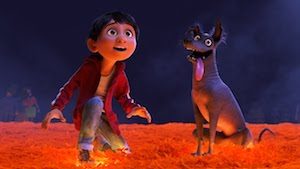
There may be nothing more central to religious life than memory. Myths, rituals, and symbols all coalesce to help us forgetful humans remember past events and people. Which is what makes the Mexican-Aztec-Catholic Dia de Muertos an important holiday, and an ideal nucleus for a movie. Hollywood has not been kind to Latino/as, but strikes a resonant chord here, extolling without exoticizing, even deepening an understanding of the rituals of the holiday for those who have only seen the spooky skeletons in most pop culture representations. Another hero’s journey, this one includes a trickster and an animal companion accompanying the hero, Miguel. Bound up with the story is the place of media, of photographs that mediate the memories, without which souls perish.
6) Novitiate
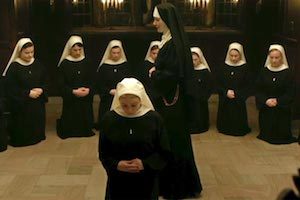
In a sense, Novitiate tells us what happens if someone doesn’t have a major traumatic experience with religious institutions. Yes, there are struggles of institutionalized power, gender inequities, and there is cruelty, but Maggie Betts’s film also tells a simpler, more universal tale about growing up and desiring, and finding one’s self and place in the world. Religious authority is not always pretty, as the film shows, but there are ways around it and expressions of individual seeking even within massive institutions like the Roman Catholic church.
5) The Shape of Water

What happens to former gods when their powers become prodded by modern science? This plotline is part of one of the best television shows of the year, Neil Gaiman’s American Gods, and it becomes the focus for Guillermo del Toro’s latest monster movie. One part Beauty and the Beast, one part Creature from the Black Lagoon, one part Enuma Elish, one part Cold War drama, del Toro’s mythical extravaganza transmutes all into a contemporary story that plays out relevant social issues like immigration, race, and disability. It’s also an ode to cinema as the atmosphere in which modern humans live, its pictures confronting humans and beast alike throughout the movie. (The main characters live above the Orpheum theater, and the cosmology of that alone would need a few paragraphs to spell out.) With chaos and cosmos in the balance, the real monsters turn out to be powerful, able-bodied men.
4) mother!

Darren Aronofsky’s over the top biblical allegory does what all good allegory does: mixes the categories, messes with the plot, switches out the characters, slips, slides, and segues until any ur-text disappears in the immediacy of the space-time of the film. The titular “mother” is Mother earth… is Mother Mary… is Lillith… is Eve. Father God is an at-first lovable but increasingly clueless, frustrating puppet master. The viewers’ sympathies are never placed with the deity, always with the humanity of the mother. Aronofsky continues his quest to audio-visualize Jewish Kabbalistic themes, threaded with some psychoanalysis, poetry, and surrealistic montages. Follow the logic through and it’s a dim view of humanity, and of G-d.
3) Mudbound

Rachel Morrison’s cinematography emphasizes the mudbound. Drawing on photos by Dorothea Lange and other WPA photographers, and paintings by Thomas Hart Benton, she visually sacralizes the profane. This is not a film about redemption in any Hollywood industrialized way, but it does provide possibilities to locate other points of power. Director and co-writer Dee Rees shows us the racist legacy of Jim Crow through its twilight, with warring, neighboring families struggling after the Second World War in an uneven playing field. The shots of the landscape provide an important milieu for the stories of racial tensions, of the racist mythology at the heart of US empire, the foibles of the myth of the American dream. Racism is banal, seeping through the ground of the country, changing oh-too-slowly.
2) Lady Bird
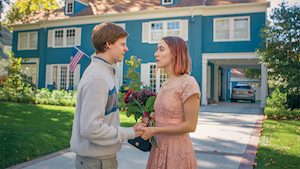 As critics have all noted, Lady Bird is a coming of age story. But it’s coming of age in the modern world without adequate rites of passage, just some ill-formed college visits, passing a driver’s license test, a few joints smoked, and awkward sexual awakenings. If any passage is marked, it’s Christine’s re-naming herself as “Lady Bird.” Barely perceptible, eddying below the surface is the place of faith. As art meets reality, Sacramento is the setting—and also the childhood home of writer-director Greta Gerwig—where Lady Bird (Saoirse Ronan) attends Catholic school. Sacramento is a sacrament, a homely-but-holy land that is contested and loved at the same time. Eventually arriving in New York City, untethered to home, Lady Bird takes to some brief experimenting, chatting up a boy with the question “Do you believe in God?” And as she stumbles out of the hospital one morning, she finds solace in a church. Part of the brilliance of the film is that we don’t see her inward feelings of faith, just some external assurances that move her along.
As critics have all noted, Lady Bird is a coming of age story. But it’s coming of age in the modern world without adequate rites of passage, just some ill-formed college visits, passing a driver’s license test, a few joints smoked, and awkward sexual awakenings. If any passage is marked, it’s Christine’s re-naming herself as “Lady Bird.” Barely perceptible, eddying below the surface is the place of faith. As art meets reality, Sacramento is the setting—and also the childhood home of writer-director Greta Gerwig—where Lady Bird (Saoirse Ronan) attends Catholic school. Sacramento is a sacrament, a homely-but-holy land that is contested and loved at the same time. Eventually arriving in New York City, untethered to home, Lady Bird takes to some brief experimenting, chatting up a boy with the question “Do you believe in God?” And as she stumbles out of the hospital one morning, she finds solace in a church. Part of the brilliance of the film is that we don’t see her inward feelings of faith, just some external assurances that move her along.
1) On Body and Soul

Many of us struggle with some kind of disability—whether physical or mental. On Body and Soul puts these at the forefront, but doesn’t obsess on their prognosis. It is a touching, slightly twisted, love story set in a slaughterhouse (with a few gruesome scenes—indeed, people in the audience fainted during its premiere at the Berlin Film Festival). The souls of the main characters seem to be connected, but they struggle to come close physically, in body—their disabilities keeping them apart. Hungarian writer-director Ildiko Enyedi creates a tender, visually acute, mystically-inclined story, activating our senses while raising questions about how we connect to each other. The film points to ways of overcoming our incomplete natures and being with other physical beings, seeking intimacy. It’s a stunning, small masterpiece.


